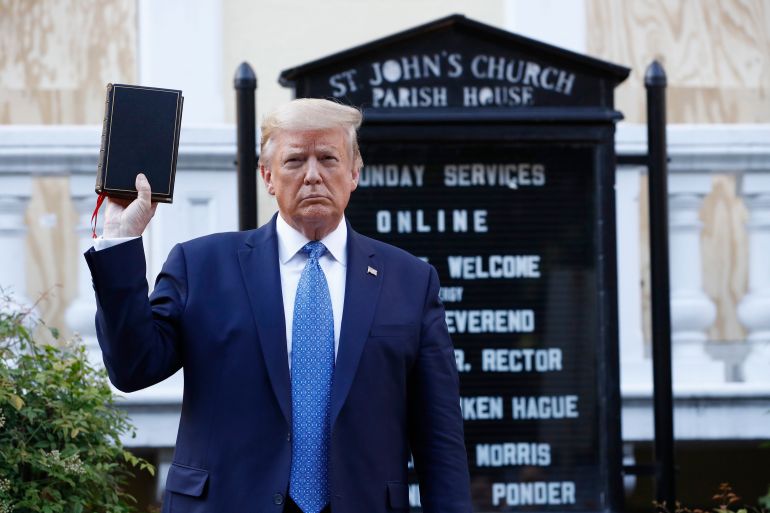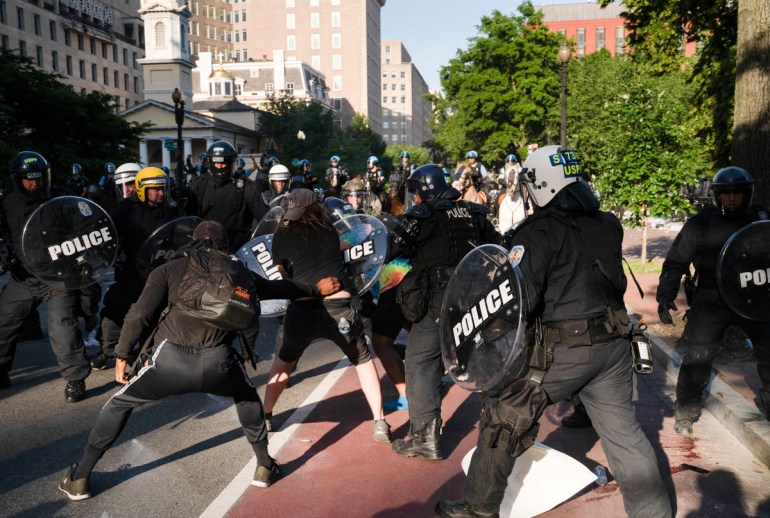Protesters’ claims against Trump for clearing DC park tossed
Judge dismisses claims brought against Trump administration clearing Lafayette Park, though some against law enforcement go ahead.

A federal judge dismissed most claims filed by activists and civil liberties groups who accused the Trump administration of violating the civil rights of protesters who were forcefully removed by police before then-President Donald Trump walked to a church near the White House for a photo op.
US District Judge Dabney Friedrich said Monday the claims in the suit, which alleged that Trump and then-Attorney General William Barr had conspired to violate the rights of protesters last June, were speculative and it was premature for the court to conclude whether the actions of law enforcement officers were justified.
Keep reading
list of 3 itemsIn dig at Biden, Trump will head to ‘lawless’ US-Mexico border
Trump wanted to send COVID-infected Americans to Guantanamo: Book
Friedrich dismissed the claims against Barr and other federal officials, including the acting US Park Police chief, Gregory Monahan, finding there was not sufficient evidence to prove there was any agreement or plan to violate the rights of the protesters. The judge also said the law gives them immunity in civil litigation.
In a 51-page decision, the judge did allow the claims against the Washington, DC Metropolitan Police Department and the Arlington, Virginia Police Department – their officers were involved in clearing the park – to proceed.
The lawsuit stemmed from one of the most high-profile moments of the Trump presidency, when federal and local law enforcement officials aggressively forced a group of largely peaceful protesters back from Lafayette Square outside of the White House, firing smoke bombs and pepper balls into the crowd to disperse the group. Officers were seen shoving protesters and journalists while pushing the crowd back.
The demonstrators rallied as part of the broader Black Lives Matter movement that swept the US last year following the death of George Floyd in Minneapolis police custody.
Barr has said he met with other law enforcement officials earlier that day to review a plan to extend the security perimeter around the White House to protect federal agents after days of unrest in Washington following the death of George Floyd at the hands of police officers in Minneapolis.
After the crowd was forcefully dispersed, Trump, followed by an entourage of his most senior aides – including Barr – along with Secret Service agents and reporters, walked over to St John’s Church, a landmark building where every president has prayed, which had been damaged a day earlier in a protest fire.
A report released earlier this month found that Trump’s photo op was not the reason for the clearing of Lafayette Square, which was previously planned to make way for construction work. Trump lauded the report as an exoneration in a statement, but it included testimony that appeared to show Barr asked for the protesters to be cleared.

The lawsuit was filed on behalf of the group Black Lives Matter D.C. and individual protesters who were present by the American Civil Liberties Union of DC, Washington Lawyers’ Committee for Civil Rights and Urban Affairs, Lawyers’ Committee for Civil Rights Under Law and the law firm of Arnold & Porter.
In a statement, Arthur Ago, director of the criminal justice project at the Lawyers’ Committee for Civil Rights Under Law, said the ruling set an “extremely dangerous precedent” and that former officials like Barr were “getting off scot-free”.
“We will always stand up for the rights of those peacefully demonstrating for racial justice, and this ruling sends the wrong message for police accountability efforts at a time when it is needed the most,” Ago said.